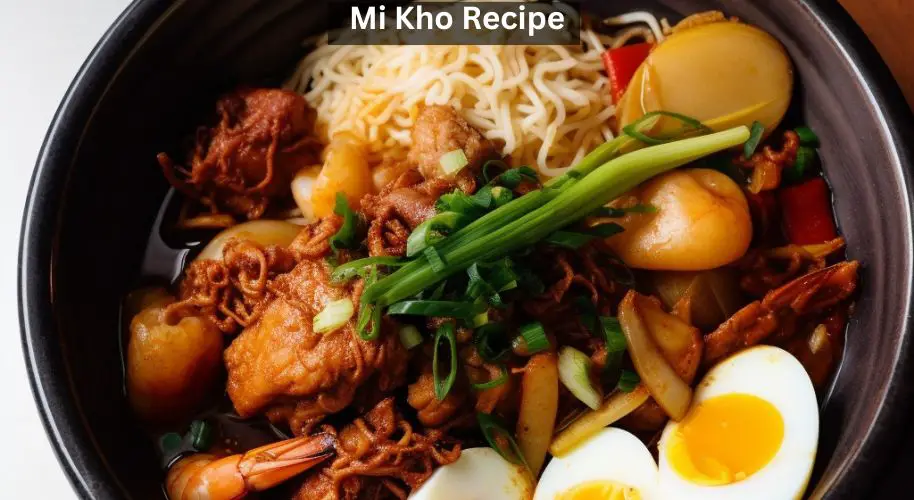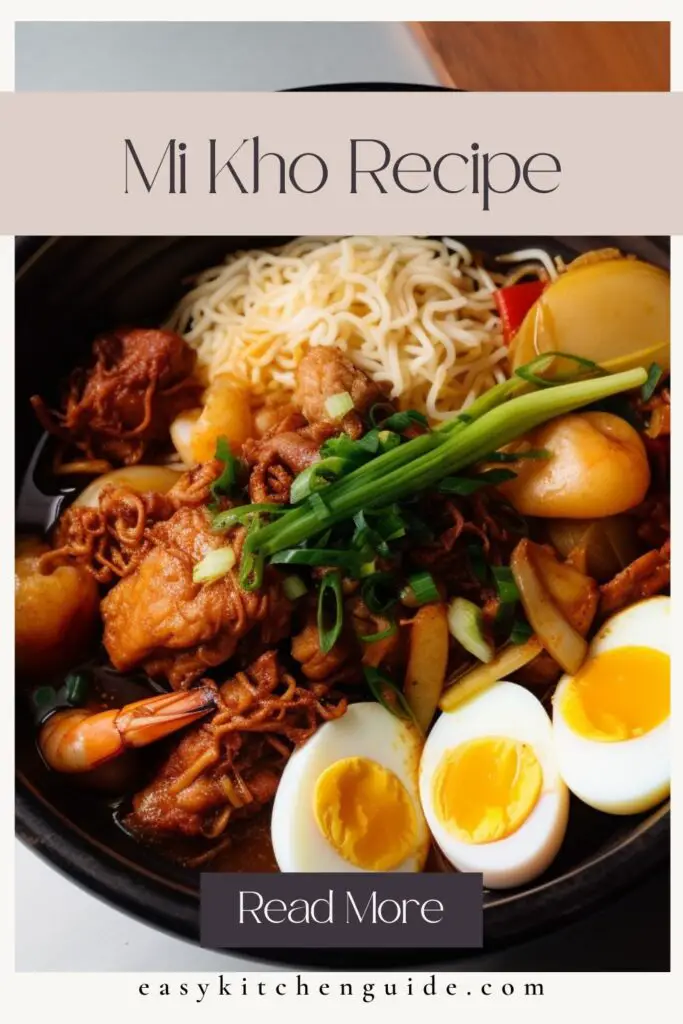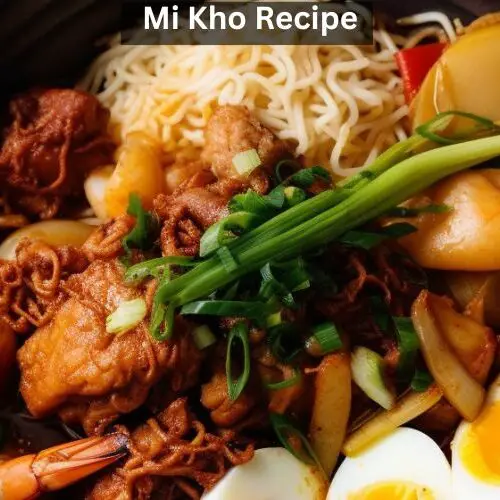This mì khô recipe, also referred to as dry egg noodles, is a comforting and delicious dish. The bowl consists of savory egg noodles with concentrated seasoning, and flavorful ingredients.
Though it may appear to be a simple dish, there are many levels of flavor and texture that come together to create this unique noodle bowl – making it totally worth the effort!
In this article, we will provide you with a step-by-step guide to making the perfect mì khô. We’ll cover the basics, from preparing and braising the pork to boiling the noodles and assembling everything together for that ultimate flavor greatness in every bite! Read on to learn how to make this delicious Vietnamese dish.

What Is Mi Kho?
Mi kho is a traditional Vietnamese dish with a variety of flavorful ingredients like pork, vegetables, and noodles. It’s often served with a side of hot soup broth and is usually garnished with chives, bean sprouts, and fried pork fat.
The dish is typically made with egg noodles but can also be served with other types of noodles like rice vermicelli or glass noodles.
This is a very popular dish in Vietnam and it is often enjoyed as part of a larger meal. If you’re looking for an easy yet flavorful dish to serve your family or guests, Mi kho is definitely worth trying. Nowadays this dish became quite trendy in the USA and Europe.
Where Did I First Try Mi Kho?
I first tried Mi kho in Saigon, Vietnam. I was visiting the country with a group of friends and we had planned an excursion to explore the city’s famous cuisine. After sightseeing throughout the day, we were looking for somewhere to have dinner when a local restaurant caught our attention.
It was one that served traditional Vietnamese dishes and we were intrigued by the variety of options on offer. We decided to take a chance and try Mi kho, an unfamiliar dish for us at the time. We found ourselves seated in a cozy corner of the restaurant and eagerly waited for our meal to arrive.
To our delight, it was delivered with a vibrant presentation that immediately caught our attention. It was accompanied by bean sprouts and chives for added flavor. As soon as we tasted it we knew that this was something special.
The contrast between the savory pork, garlic and oyster sauce was complemented by the spicy Chinese mustard and rice vinegar. The pork fat cubes added a pleasant texture to it all.
We even looked around the restaurant and could see that this was a popular dish among the locals. We enjoyed it so much that we ordered a second round right away. It’s safe to say that our first experience with Mi Kho left us wanting more.
You May Also Like These Dinner Recipes:
- Recipe for King Taco Carne Asada
- Recipe for Tassili’s Kale Wrap
- Bojangles Fried Chicken Recipe (Copycat version)
Ingredients
- Egg Noodles: Egg noodles are the main ingredient in Mi kho, and they’re responsible for creating the chewy texture that’s so characteristic of this dish.
- Pork: Pork shoulder is most commonly used in this recipe, though you can use any type of pork you like. Be sure to cut it into thin strips before adding it to the recipe.
- Pork Bones or Pork Spareribs: Pork bones and/or spareribs are also added to Mi kho, which gives it a richer flavour and thicker consistency.
- Dry Squid or Dry Shrimp: These ingredients help to add extra umami flavour to Mi kho. Toast them for 3 minutes before adding them to the recipe.
- Salt: Salt helps to bring out the flavours of all the other ingredients in Mi kho and adds an extra layer of flavor.
- Neutral Cooking Oil: Neutral cooking oil is used for sautéing and stir-frying the various ingredients in this dish. It helps create a smoother texture and prevents food from sticking to the pan.
- Garlic: Garlic is a key ingredient in Mi kho, as it adds a lot of flavour and aroma to the dish. Mince or finely chop garlic before adding it to the recipe.
- Oyster Sauce: Oyster sauce brings sweetness and umami flavours to Mi kho. It’s a key ingredient in many Chinese recipes, and it complements the other flavours in this dish perfectly.
- Soy Sauce: Soy sauce adds a layer of salty flavour that pairs well with the other ingredients in Mi kho. Use light soy sauce for the best results.
- Chinese Cooking Wine: Chinese cooking wine is an essential ingredient in this recipe, as it helps to bring out the flavours of all the other ingredients.
- Sugar: Sugar adds sweetness and balance to Mi kho and helps to bring out its umami flavor.
- Rice Vinegar: Rice vinegar has a mild acidic taste that rounds out Mi kho and adds depth of flavor.
- Raw Pork Fat: Raw pork fat is used to create the tep mo, or crispy fried pork pieces, which are a key part of this dish. Cut the pork fat into small cubes before adding it to the pan.
- Bean Sprouts: Bean sprouts add crunchy texture and freshness to Mi kho. Blanch them for a few minutes before adding them to the recipe.
- Chives: Chives add an extra layer of flavor and bright green color to this dish. Cut them into 2-inch pieces before adding them to the pan.
- Spicy Chinese Mustard: Spicy Chinese mustard is used in Mi Kho for a bit of heat. Add as much as you like, depending on your preference.
- Rice Vinegar: Rice vinegar adds a hint of acidity to the dish that helps to balance out all the flavors.
- Shrimp: Shrimp can be added to Mi kho for extra flavor and protein. Be sure to toast them for a few minutes before adding them to the dish.

Directions
Making XA XIU
Step 1:
In a large bowl, combine the water, garlic powder, soy sauce, cooking wine, salt and onion powder. Mix until all ingredients are combined.
Step 2:
Place pork shoulder in the marinade and let it sit in the fridge for at least 4 hours or overnight.
Step 3:
Remove pork from the marinade and pat dry with paper towels.
Step 4:
Place pork in a roasting pan and sprinkle the Chinese barbecue seasoning over it. Roast at 375°F for 25 minutes or until internal temperature reaches 165°F.
Step 5:
Slice the pork into thin strips
Making Broth
Step 1
Add the pork bones or pork ribs to a large pot and cover with tap water. Add 2 tablespoons of salt, then bring the mixture to a boil over high heat.
Step 2
Turn off the heat and drain the liquid. Rinse the pork thoroughly under running water and clean them properly.
Step 3
Place the pot back onto the stove and add all remaining broth ingredients. Increase the heat to high until the mixture reaches a boil, then reduce it to medium-low to maintain a low boil.
Step 4
Simmer for two hours or until the pork meat is soft. Discard the onion, shrimp and squid before checking if the pork is cooked through.
Step 3: Prepare TEP MO
Cut the pork fat into 1/2″ cubes and sauté in a pan over medium-high heat until it’s crisp. Once done, take it out of the pan and set aside for later use.
Step 4: Prepare Noodle Seasoning
Heat a small saucepan over medium heat, then add oil and shallot. Saute until fragrant, then add the remaining ingredients and bring to a boil. Taste and adjust flavorings as needed, then remove from heat.
Step 5: Assemble the Noodles
Cook the noodles according to the package instructions and divide them into 8 individual bowls. Top each bowl with xa xiu, fried pork fat, shrimp and seasonings of your choice. Now, serve with a small side dish of soup.
Cooking Tips
• Be sure to cut the pork into thin strips before adding it to the pan.
• Toast the dry squid or shrimp for 3 minutes over medium-high heat before adding them to the wok. This helps bring out their flavor and gives Mi Kho an extra layer of umami taste.
• If you want to make the dish spicier, add more spicy Chinese mustard or chilli peppers.
What Ingredients Can I Replace or Substitute While Making It?
• If you don’t have pork bones or spare ribs, you can use either boneless pork shoulder or pork belly instead.
• If you don’t have Chinese cooking wine, you can substitute dry sherry or Shaoxing rice wine.
• To make the recipe vegetarian-friendly, use firm tofu instead of pork.
• If you don’t have oyster sauce, you can substitute hoisin sauce for a similar flavor and color.
• If you don’t have chives, you can use green onions instead.
• You can add any other vegetables of your choice to this dish such as mushrooms or bell peppers.
• If you don’t have pork fat, you can substitute bacon or lard.
• If you want to make Mi kho gluten-free, use tamari instead of soy sauce.

Mi Kho Recipe
Equipment
- bowl
- knife
Ingredients
- 4 pieces of shrimp adding a delicate and seafood flavor to the dish, providing a delightful texture and a touch of elegance.
- 1 lb of thin egg noodles creating a light and springy base for the dish, capturing and absorbing the flavors of the broth and seasonings, resulting in a satisfying and hearty noodle dish.
XA XIU (CHAR SIU PORK):
- 1 tsp of garlic powder infusing the pork with a savory and aromatic flavor, enhancing the overall taste profile of the dish.
- 1 tsp of onion powder adding a subtle and sweet onion note to the marinade, contributing to the depth of flavors in the char siu pork.
- 1/4 tsp of salt enhancing the overall taste of the marinade and helping to tenderize the pork, resulting in a juicy and flavorful finished product.
- 1 lb of pork shoulder a tender cut of meat ideal for marinating and grilling, providing a succulent and savory element to the dish.
- 1 Tbsp of light soy sauce adding a salty and umami-rich flavor to the marinade, enhancing the overall taste profile of the char siu pork.
- 1 Tbsp of cooking wine tenderizing the pork and adding a subtle depth of flavor to the marinade, resulting in a flavorful and aromatic dish.
- 1/2 cup of filtered water providing moisture and creating a flavorful base for the marinade, ensuring the pork absorbs the flavors thoroughly.
- 1/4 bag of Chinese barbecue seasoning a blend of spices and herbs that adds a distinct and savory flavor to the char siu pork, giving it a rich and aromatic taste.
BROTH PREP:
- 1-3/2 lb of pork bones or pork spare ribs I like half of each, contributing a rich and savory flavor to the broth, creating a hearty and satisfying base for the dish.
- 1 Tbsp of salt enhancing the overall taste of the broth, bringing out the flavors of the other ingredients and providing a savory note.
- Half the amount of tap water serving as the liquid component for the broth, ensuring proper hydration and creating a flavorful base for the soup.
BROTH:
- 1 Tbsp of dry squid adding a unique and savory flavor to the broth, infusing it with a delightful seafood essence.
- 7 cups of filtered water serving as the liquid base for the broth, ensuring proper hydration and creating a flavorful and comforting soup.
- 1 Tbsp of sugar balancing the flavors of the broth, adding a touch of sweetness to complement the savory notes.
- 1 medium onion adding a mild and sweet onion flavor to the broth, enhancing the overall depth of flavors.
- 1 Tbsp of salt enhancing the overall taste of the broth, bringing out the flavors of the other ingredients and providing a savory note.
- 3 pcs of shrimp adding a delicate and seafood flavor to the broth, providing a delightful texture and a touch of elegance.
- 1/2 tsp of MSG enhancing the umami taste of the broth, adding depth and richness to the overall flavor profile.
NOODLE SEASONING:
- 2 Tbsp of soy sauce adding a savory and salty flavor to the noodles, enhancing the overall taste profile and providing a rich umami note.
- 2 Tbsp of oyster sauce contributing a rich and savory flavor to the noodles, adding depth and complexity to the overall taste.
- 4 Tbsp of water providing moisture and creating a flavorful base for the seasoning, ensuring the noodles are well coated with the sauce.
- 1/2 Tbsp of minced garlic adding a pungent and aromatic flavor to the seasoning, infusing the noodles with a delightful garlic aroma and taste.
- 1 Tbsp of neutral cooking oil adding richness and a smooth mouthfeel to the seasoning, enhancing the overall taste and texture of the dish.
- 1 Tbsp of rice vinegar providing a tangy and slightly acidic flavor to the seasoning, balancing the richness of the other ingredients and adding a refreshing note.
- 1 Tbsp of Chinese cooking wine adding a subtle depth of flavor to the seasoning, enhancing the overall taste profile of the dish.
- 1 Tbsp of sugar balancing the flavors of the seasoning, adding a touch of sweetness to complement the savory and umami notes.
TEP MO (FRIED PORK FAT):
- 1/4 lb of raw pork fat for tep mo providing a rich and indulgent flavor to the dish, adding a luscious and decadent element to the overall taste profile.
ACCOUTREMENT:
- Half the amount of rice vinegar adding acidity and brightness to the dish, providing a refreshing contrast to the rich and savory flavors.
- Half the amount of spicy Chinese mustard adding a bold and spicy kick to the dish, enhancing the overall taste and providing a unique and exciting flavor element.
- 1/2 lb of bean sprouts blanched, adding a refreshing and crunchy texture to the dish, providing a light and crisp element that complements the other ingredients.
- 1 bunch of chives cut into 2″ pieces, adding a mild and onion-like flavor to the dish, enhancing the overall taste profile and providing aUnfortunately, it seems that the ingredient list you provided is incomplete. Could you please provide the missing ingredients or clarify any additional details?
Instructions
Making XA XIU
- In a large bowl, combine the water, garlic powder, soy sauce, cooking wine, salt and onion powder. Mix until all ingredients are combined.
- Place pork shoulder in the marinade and let it sit in the fridge for at least 4 hours or overnight.
- Remove pork from the marinade and pat dry with paper towels.
- Place pork in a roasting pan and sprinkle the Chinese barbecue seasoning over it. Roast at 375°F for 25 minutes or until internal temperature reaches 165°F.
- Slice the pork into thin strips
Making Broth
- Add the pork bones or pork ribs to a large pot and cover with tap water. Add 2 tablespoons of salt, then bring the mixture to a boil over high heat.
- Turn off the heat and drain the liquid. Rinse the pork thoroughly under running water and clean them properly.
- Place the pot back onto the stove and add all remaining broth ingredients. Increase the heat to high until the mixture reaches a boil, then reduce it to medium-low to maintain a low boil.
- Simmer for two hours or until the pork meat is soft. Discard the onion, shrimp and squid before checking if the pork is cooked through.
- Cut the pork fat into 1/2" cubes and sauté in a pan over medium-high heat until it's crisp. Once done, take it out of the pan and set aside for later use.
- Heat a small saucepan over medium heat, then add oil and shallot. Saute until fragrant, then add the remaining ingredients and bring to a boil. Taste and adjust flavorings as needed, then remove from heat.
- Cook the noodles according to the package instructions and divide them into 8 individual bowls. Top each bowl with xa xiu, fried pork fat, shrimp and seasonings of your choice. Now, serve with a small side dish of soup.
Notes
- Be sure to cut the pork into thin strips before adding it to the pan.
- Toast the dry squid or shrimp for 3 minutes over medium-high heat before adding them to the wok. This helps bring out their flavor and gives Mi Kho an extra layer of umami taste.
- If you want to make the dish spicier, add more spicy Chinese mustard or chilli peppers.
Nutrition Information
Mi kho is a nutritious and flavorful dish that is high in protein, vitamins, and minerals. This recipe provides the following nutritional information per serving:
• Calories: 927 kcal
• Protein: 32 g
• Fat: 24 g
• Carbohydrates: 19 g
• Fiber: 4 g
• Vitamin A: 24% of the RDI
• Vitamin B6: 10% of the RDI
• Vitamin C: 9% of the RDI
• Calcium: 8% of the RDI
• Iron: 15 % of the RDI.
How to Store Leftover Mi kho?
You can store leftover Mi Kho in an airtight container in the refrigerator for up to three days. Reheat using the microwave or stovetop before serving. If you want to freeze it, place it in a freezer-safe container and store it for up to 3 months.
To reheat, thaw overnight in the refrigerator and then heat in the microwave or on the stovetop until warmed through.
FAQs
Can pregnant women eat this?
Yes, as long as all the ingredients are cooked through and all the necessary safety precautions are taken. Pregnant women should avoid eating raw or undercooked pork, eggs, and seafood.
It is also important to ensure that all ingredients for this dish have been properly stored and handled.
Is this dish spicy?
The level of spiciness in Mi Kho depends on the amount of Chinese mustard you add. If you prefer a milder flavor, reduce the amount or omit it altogether. You can also adjust the heat by adding more or fewer chili peppers.
Can I substitute for pork fat cubes?
Yes, you can substitute bacon or lard for the pork fat cubes. A pork belly or shoulder can also be used, but they are usually not as flavorful. If you want to make Mi kho vegetarian-friendly, use firm tofu instead of pork.
Can I make this dish gluten-free?
Yes, you can make Mi Kho gluten-free by using tamari instead of soy sauce. To ensure that all other ingredients are also gluten-free, check the labels on any pre-made seasonings or sauces before using them.
You should also avoid adding Chinese cooking wine and replace it with dry sherry or Shaoxing rice wine instead.
Wrapping Up
Thank you for reading about this delicious and nutritious Vietnamese dish, Mi Kho. This savory, sweet, and spicy noodle dish is easy to make at home with minimal ingredients. Serve it with steamed jasmine rice for a complete meal or enjoy it on its own as a light lunch.
You can customize the recipe according to your taste preferences by adding different vegetables or proteins of your choice. Mi Kho can also be made gluten-free with a couple of simple substitutions.
We hope you find it helpful. Try this at home, you will love its unique flavor and texture. Please share this recipe with your friends and family.
You Might Also Like These Recipes!
- Recipe of Mario Batali Sunday Gravy
- Ina Garten Black Bean Soup Copycat Recipe
- Panera Bread Sierra Turkey Sandwich Copycat Recipe
Dr. Leah Alexander, M.D., is a board-certified Pediatrician in New Jersey and has been working at Elizabeth Pediatric Group of New Jersey since 2000.
She also has a passion for culinary arts that extends beyond the medical realm. After completing culinary school at the French Culinary Institute, she started Global Palate, LLC, a catering firm, in 2007. She ran her own six-year-old catering company and served small group parties as an owner and executive chef.
